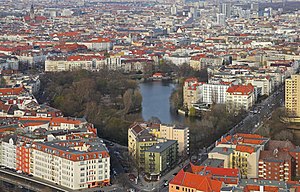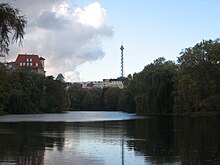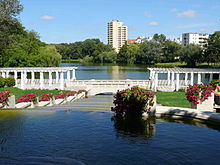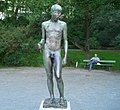Lietzensee
| Lietzensee | ||
|---|---|---|

|
||
| The Lietzensee (northern part) and surrounding buildings | ||
| Geographical location | Berlin-Charlottenburg | |
| Data | ||
| Coordinates | 52 ° 30 '28 " N , 13 ° 17' 18" E | |
|
|
||
| surface | 6.6 ha | |
| Maximum depth | 4 m | |
The Lietzensee is an inner-city lake in the Berlin district of Charlottenburg in the Charlottenburg-Wilmersdorf district . The sickle-shaped lake has an area of 6.6 hectares and is three to four meters deep. The surrounding parks of the Lietzenseepark are another 10.1 hectares. The park was laid out in 1918–1920 by gardening director Erwin Barth .
Origin of name
The name Lietzensee comes from the village of Lietzow or Lützow, which was incorporated into the then city of Charlottenburg in 1719. It belonged to the Benedictine convent of St. Marien and was used by the nuns as a fish pond. The words Lietzow, Lützow, Lusce , u. are derived from the Slavic word luccina , which means something like ' swamp ' or ' pool '.
The name is often traced back to the old Berlin name Lietze for the coot . In the organ of the German Ornithological Society from 1855 the entry can be found:
“Fulica atra, pale duck, Lietze. (This is the name of a lake near Charlottenburg on which this bird is frequent, the Lietzensee). "
A legend provides a third explanation for the name Lietzensee: Old residents of the area reported that many years ago an entire place, which was the village of Lützow (Lietzow), had sunk into the lake. The reason for the sinking is not known, but sometimes the fishermen hit the sunken church spire with their boats in the middle of the lake or their nets get caught on it. Therefore, the water is not suitable for fishing. In the village of Charlottenburg, which emerged from the village of Lietzow, it is said to have haunted in later times - there are reports of sudden fires in the ground or dogs ghosting around.
Geography and location
The Lietzensee is located in the densely populated area of Witzleben , which is bordered to the north by Kaiserdamm , to the west by the route of the Ringbahn , to the south by the Stadtbahn route and to the east by Suarezstrasse. Since 1904, the lake has been divided into a north and south half by a dam that was built up for Neue Kantstrasse , which has been connected by an underpass since 1954.
Geologically , the Lietzensee is the northernmost lake in the Grunewald chain of lakes , which developed on the floor of an glacial glacial valley . Today it is completely fed by groundwater , and it drains underground into the Spree in the north . Since the lake has no inflow, the water quality is not suitable for swimming. Since the lack of oxygen has also led to the death of fish, aeration devices were installed in the lake.
History of the lake and the Lietzensee park

The lake existed before the area was settled and was located in the middle of a forest. In 1824 Job von Witzleben , who later became the Prussian Minister of State and War , acquired the Lietzensee and had the first parks laid out in the following years. As a special attraction he wanted to build an island in the middle of the lake. But no matter how much rubble and earth the contracted builders poured into the water, the material was not enough and so the project had to be abandoned. After Witzleben's death in 1837, the lake changed hands several times. In 1840, the art gardener Ferdinand Deppe acquired the property and made it a special attraction with a rose and georgin cultivation . Nevertheless, the parks remained open to the public.
In 1905 elegant apartment buildings were built directly on the east bank of the Lietzensee. Three green areas were left out: Witzlebenplatz , Kuno-Fischer-Platz and Dernburgplatz. A resolution by the Charlottenburg city council in 1910 prevented total development on the west and north banks. This division of the bank area has been preserved to this day.
As a job creation measure , under the direction of Erwin Barth, new green spaces were created around the Lietzensee in Art Nouveau style from 1918 to 1920 . The drafts for this date from 1912, the year in which Barth was appointed garden director of Charlottenburg.
The resulting buildings include
- the Great Cascade , created in 1912/1913 by Erwin Barth and Heinrich Seeling at the southern end of the lake, Dernburgplatz, (restored in 2005/2006 by the Berlin Monument Protection Foundation)
- the small cascade on the north-west bank,
- the park ranger house of Rudolf Walter of 1924/1925.
There are several monuments and sculptures in the park. a. Since 1925 the monument to the fallen of the Queen Elisabeth Guard Regiment No. 3 by Eugen Schmohl . A Diana created for this park as well as an archer by Hugo Lederer were melted down in 1943 during the Second World War in favor of weapons production. In 1962 the city received a sandal loosening boy from the estate of the sculptor Fritz Röll . The work, which was awarded the Grand State Prize in 1909 , was installed here. There is also a spearman by Bernhard Bleeker (1940), a bird bath with two sea lions by Rosemarie Henning (1955) and two aluminum sculptures by Volkmar Haase from the 1990s.
The park has been a listed garden complex since the 1990s . The Great Cascade and the car park ranger's house are architectural monuments .
In 1992 the Great Cascade was used as the location for Otto Waalke's film Otto - The Love Film .
- Picture gallery
Fritz Röll : Sandal Binder , 1909
Bernhard Bleeker : Spearman , 1940
Volkmar Haase : Tangential contact , 1990
Lietzensee with Lietzensee bridge on Neue Kantstrasse
Stately development from the Empire on the east bank of the lake
literature
- Irene Fritsch: Life at the Lietzensee . edition Berlin by Metropol Verlag, Berlin 2001, ISBN 3-932482-90-5 .
- Sonja Miltenberger: Charlottenburg in historical maps and plans . Berlin 1998, ISBN 3-932202-32-5 .
- Achim Rosenhahn: Lietzensee - Pictures & Thoughts II . Berlin 2016, ISBN 978-3-944658-41-4 .
Web links
- Lietzensee at the environmental agency in Charlottenburg
- Lietzenseepark. In: berlin.de. July 24, 2006, accessed February 24, 2018 .
- Historical plans by Erwin Barth
- Charlottenburg-Wilmersdorf: Green areas - Dernburgplatz. In: berlin.de. Retrieved February 24, 2018 .
- Kuno-Fischer-Platz. In: berlin.de. April 6, 2010, accessed February 24, 2018 .
- Berlin Monument Protection Foundation
- Citizens for the Lietzensee e. V.
- Neighborhood walks: Lietzensee and Lietzenseepark
Individual evidence
- ↑ Irene Fritsch: Life on Lietzensee . edition Berlin in Metropol Verlag, Berlin 2001, ISBN 3-932482-90-5 ; P. 12.
- ^ Organ of the German Ornithologists Society, 1855 - Internet Archive
- ↑ a b The Lietzensee and the Spook in Charlottenburg . In: The Stralauer Fischzug. Legends, stories and customs from old Berlin. New Life Publishing House, Berlin 1987, ISBN 3-355-00326-3 ; S 108/109
- ^ Charlottenburg-Wilmersdorf: More oxygen for the fish in the Lietzensee. In: Berliner Morgenpost. Retrieved May 24, 2017 .
- ↑ Free-standing works of art . In: Berliner Adreßbuch , 1936, part 3, p. 167 (Charlottenburg, Lietzenseepark).
- ↑ a b LDL Berlin Lietzenseepark with the former Dernburgplatz and Witzlebenplatz
- ↑ LDL Berlin parking attendant's building, Wundtstrasse 39









